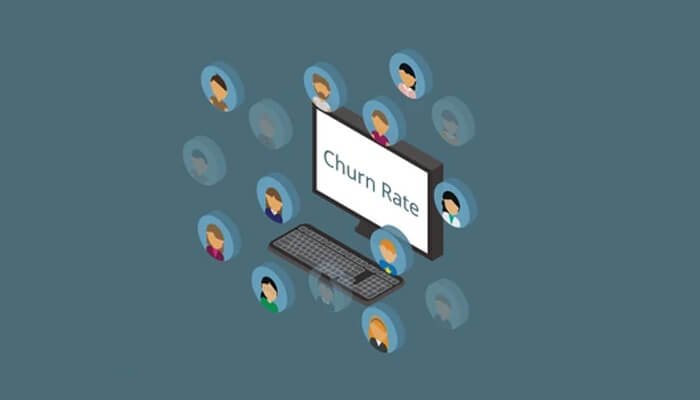Customer churn rate is a critical metric to calculate for every company with a subscription-based business model. By quantifying the number of customers you’ve gained or lost in a given period, you can determine the revenue coming into the business, make future plans, and start to understand the impact of different strategies. Tracking churn rate offers new insights into your business and how it’s viewed by your customers.
The hardest sales conversion is acquiring new customers. You have to go out and find people or businesses interested in your product, then convince them of its value. This requires marketing and sales processes, typically expressed as an average customer acquisition cost (CAC).
In contrast, it’s easier and more valuable to hold onto what you already have, maintaining existing customers. Long-term customers continue to bring money through the door while only incurring operational and customer service costs.
Customers who sign up for just a short period before canceling typically don’t recoup their CAC, costing your business money. That’s why it’s so important to calculate your churn rate and find ways to minimize the number of customers walking away from your business.
What is churn rate?
In its simplest form, churn rate is the number of customers that choose to cancel or not renew their subscription over a given time period. Typically churn rate is calculated over a month or year and expressed as a percentage of the initial number of customers.
Businesses can track their customers and revenue using accounts payable software and CRM (Customer relationship management) tools deriving the final churn rate for a given period.
A high churn rate shows a large number of people stopped buying your service, suggesting deeper issues with your value proposition. To be successful, companies need to track any dips, and work to minimize it at all times.
While calculating churn rate might seem trivial, there’s much more to it than meets the eye. To make the most of the metric, you have to understand the nuances in the numbers.
Churn rate challenges – Making sense of the numbers
While you may come across definitive churn rate formulas, these generalized approaches offer a surface-level overview of company performance while papering over the fine details. In reality, it isn’t easy to accurately and consistently track churn rate.
This is before you even get into the many different ways of calculating churn rates to gain deeper insights into your company. Companies can learn about who’s leaving and why by separating customers into segments based on various factors.
For example, it’s often a good idea to analyze first-time customers and how they came to use your service separately. Did they sign up using a special offer or discount, and did they choose to continue using the service at the full price? By understanding the typical churn rate for these customers, you can calculate the signup discount to offer where enough people keep the service and ensure you still make a profit.
Listed below are three specific challenges to accurately calculating customer churn rates:
1. Counting can be harder than it looks
Typical churn rate formulas tell you to divide the number of lost customers by the total number of customers at the start of the period. To do this, you must choose how to count these two numbers. What sounds simple actually masks some complexity, and these two numbers are harder to define than you might expect.
Let’s assume we’re calculating the churn rate for a given month. There are three main types of customers:
- Retained customers who previously signed up and will come up for renewal during the month.
- New customers who sign up during the month.
- Lost customers who cancel during the month.
A spike in signups can quickly distort churn rate. If it happens before the period you’re calculating for, you’ll have a disproportionately high number of “retained” customers. Now, suppose it occurs during the month you’re calculating for. In that case, it may lead to miscounting the actual number of “lost” customers, i.e., failing to track specific lost customers if the number is higher at the end of the month compared to the start.
Additionally, you have to decide at what point the customer is considered “lost.” Is it when the subscription ends or when they choose to cancel? If a customer signs up because of a discount and immediately cancels, are they part of this month’s churn or next, and are they counted in next month’s retained customers?
Typically, businesses consider churn when the next payment does not arrive, as until then, you have a chance to entice them back into subscribing. Others choose the moment of cancellation as the “churn point,” but this can lead to strange results. For example, under this system, it is possible to lose more customers in a month than you started with.
2. Consider the sample size
The scale of your customer base dramatically impacts churn rate figures. Losing a hundred customers is much less concerning if you started with 10,000 (churn rate = 1%) than if you started with 500 (churn rate = 20%).
Churn rate is a ratio, so it’s as much a reflection of your initial number of customers as it is the number of lost customers. This can complicate things for new and rapidly growing businesses with a large number of customers signing up.
You don’t have a backlog of data for different market segments and how they have behaved in the past for comparison. You only have a small data set containing information on a volatile period. This leads to huge churn rate fluctuations that are hard to draw conclusions from.
3. Churn variations across different services
You will typically see significant variations if you offer multiple services catering to different markets. We previously discussed how it is important to segment your customers to gain more meaningful insights. The same applies when you have different subscription plans and pricing.
Aggregated churn rates across the entire company can obscure behavior unique to specific products. For example, a struggling service plan that needs a price change or a naturally higher churn segment (e.g., introductory service) that brings down the company average. Without digging deeper into the numbers, businesses may make decisions based on misinformation.
Consistency and context are key when it comes to calculating churn rate
Churn rate is a fundamental factor when making decisions in subscription-based businesses. However, using it effectively requires consistency and context. You need to apply the same rules when defining total and lost customers, and you need to understand any context that may skew results. Also, remember that churn is inherently a lagging indicator and typically needs to be considered over a longer time frame, not in real time.



